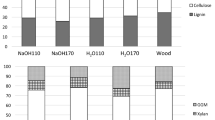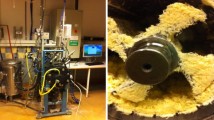Abstract
A new, robust method for measuring the average pore size of water-swollen, cellulose I rich fibres is presented. This method is based on the results of solid-state NMR, which measures the specific surface area (area/solids mass) of water-swollen samples, and of the fibre saturation point (FSP) method, which measures the pore volume (water mass/solids mass) of water-swollen samples. These results are suitable to combine since they are both recorded on water-swollen fibres in excess water, and neither requires the assumption of any particular pore geometry. The new method was used for three model samples and reasonable average pore size measurements were obtained for all of them. The structural characterization of water-swollen samples was compared with the dry structure of fibres as revealed using BET nitrogen gas adsorption after a liquid exchange procedure and careful drying. It was concluded that the structure of the water-swollen fibres sets an upper limit on what is obtainable in the dry state.



Similar content being viewed by others
References
Andreasson B, Forsstrom J, Wågberg L (2003) The porous structure of pulp fibres with different yields and its influence on paper strength. Cellulose 10(2):111–123
Annergren G, Wågberg L (1997) Physiochemical characterization of papermaking fibres. The fundamentals of papermaking materials: Transaction of the 11th Fundamental Research Symposium held at Cambridge
Brunauer S, Emmett PH, Teller E (1938) Adsorption of gases in multimolecular layers. J Am Chem Soc 60:309–319
Chunilall V, Bush T, Larsson PT, Iversen T, Kindness A (2010) A CP/MAS C-13-NMR study of cellulose fibril aggregation in eucalyptus dissolving pulps during drying and the correlation between aggregate dimensions and chemical reactivity. Holzforschung 64(6):693–698
Earl WL, Vanderhart DL (1980) High-resolution, magic angle sample spinning C-13 Nmr of solid cellulose-I. J Am Chem Soc 102(9):3251–3252
Fink HP, Hofmann D, Philipp B (1995) Some aspects of lateral chain order in cellulosics from X-ray-scattering. Cellulose 2(1):51–70
Forsstrom J, Andreasson B, Wågberg L (2005) Influence of pore structure and water retaining ability of fibres on the strength of papers from unbleached kraft fibres. Nord Pulp Paper Res J 20(2):176–184
Herrington TM, Midmore BR (1984) Adsorption of Ions at the Cellulose Aqueous-Electrolyte Interface. Part 2. Determination of the Surface-Area of Cellulose Fibers. J Chem Soc Faraday Trans I 80:1539–1552
Hult EL, Larsson PT, Iversen T (2001) Cellulose fibril aggregation—an inherent property of kraft pulps. Polymer 42(8):3309–3314
Jakob HF, Fengel D, Tschegg SE, Fratzl P (1995) The elementary cellulose fibril in Picea abies: comparison of transmission electron microscopy, small-angle X-ray scattering, and wide-angle X-ray scattering results. Macromolecules 28(26):8782–8787
Jarvis MC (1994) Relationship of chemical-shift to glycosidic conformation in the solid-state C-13 Nmr-Spectra of (1–4)-linked glucose polymers and oligomers—anomeric and related effects. Carbohydr Res 259(2):311–318
Kohnke T, Lund K, Brelid H, Westman G (2010) Kraft pulp hornification: a closer look at the preventive effect gained by glucuronoxylan adsorption. Carbohydr Polym 81(2):226–233
Krässig HA (1996) Cellulose structure, accessibility and reactivity, polymer monographs, vol 11. Gordon and Breach Science Publishers
Larsson PT, Westlund PO (2005) Line shapes in CP/MAS C-13 NMR spectra of cellulose I. Spectroc Acta Pt A-Molec Biomolec Spectr 62(1–3):539–546
Larsson PT, Wickholm K, Iversen T (1997) A CP/MAS C-13 NMR investigation of molecular ordering in celluloses. Carbohydr Res 302(1–2):19–25
Li T-Q, Henriksson U, Ödberg L (1993) Determination of pore sizes in wood cellulose fibres by 2H and 1H NMR. Nord Pulp Paper Res J 3:326–330
Maloney TC, Paulapuro H, Stenius P (1998) Hydration and swelling of pulp fibers measured with differential scanning calorimetry. Nord Pulp Paper Res J 13(1):31–36
Moura MJ, Ferreira PJ, Figueiredo MM (2005) Mercury intrusion porosimetry in pulp and paper technology. Powder Technol 160(2):61–66
Newman RH (1992) Solid-State C-13 Nmr-Spectroscopy of Multiphase Biomaterials. ACS Symp Ser 489:311–319
Nocanda X, Larsson PT, Spark A, Bush T, Olsson A, Madikane M, Bissessur A, Iversen T (2007) Cross polarisation/magic angle spinning C-13-NMR spectroscopic studies of cellulose structural changes in hardwood dissolving pulp process. Holzforschung 61(6):675–679
Östlund Å, Köhnke T, Nordstierna L, Nyden M (2010) NMR cryoporometry to study the fiber wall structure and the effect of drying. Cellulose 17(2):321–328
Park S, Venditti RA, Jameel H, Pawlak JJ (2006) Changes in pore size distribution during the drying of cellulose fibers as measured by differential scanning calorimetry. Carbohydr Polym 66(1):97–103
Stone JE, Scallan AM (1966) Influence of drying on the pore structures of the cell wall. In: Consolidation of the paper web: transactions of the symposium, Cambridge, vol 1, pp 145–174
Stone JE, Scallan AM (1967) The effect of component removal upon the porous structure of the cell wall of wood II. Swelling in water and the fibre saturation point. Tappi 50(10):496–501
Svensson A, Larsson PT, Salazar-Alvarez G, Wågberg L (2013) Preparation of dry ultra-porous cellulosic fibres: characterization and possible initial uses. Carbohydr Polym 92(1):775–783
Teeäär R, Serimaa R, Paakkari T (1987) Crystallinity of Cellulose, as Determined by Cp/Mas Nmr and Xrd Methods. Polym Bull 17(3):231–237
Valckenborg RME, Pel L, Kopinga K (2002) Combined NMR cryoporometry and relaxometry. J Phys D-Appl Phys 35(3):249–256
Vanderhart DL, Atalla RH (1984) Studies of microstructure in native celluloses using solid-state C-13 Nmr. Macromolecules 17(8):1465–1472
Wang XS, Maloney TC, Paulapuro H (2003) Internal fibrillation in never-dried and once-dried chemical pulps. Appita J 56(6):455–459
Wickholm K, Larsson PT, Iversen T (1998) Assignment of non-crystalline forms in cellulose I by CP/MAS C-13 NMR spectroscopy. Carbohydr Res 312(3):123–129
Yamamoto H, Horii F (1993) Cp Mas C-13 Nmr analysis of the crystal transformation induced for Valonia cellulose by annealing at high-temperatures. Macromolecules 26(6):1313–1317
Acknowledgments
Dr. Derek Weightman at Sappi Saiccor in South Africa is kindly acknowledged for supplying samples of the eucalyptus dissolving pulp. Domsjö Fabriker AB is acknowledged for supplying the softwood dissolving pulp. Thanks are expressed to German Salazar-Alvarez at the Department of Material and Environmental Chemistry, Stockholm University, Stockholm, for help with the BET nitrogen gas adsorption measurements.
Author information
Authors and Affiliations
Corresponding author
Rights and permissions
About this article
Cite this article
Larsson, P.T., Svensson, A. & Wågberg, L. A new, robust method for measuring average fibre wall pore sizes in cellulose I rich plant fibre walls. Cellulose 20, 623–631 (2013). https://doi.org/10.1007/s10570-012-9850-x
Received:
Accepted:
Published:
Issue Date:
DOI: https://doi.org/10.1007/s10570-012-9850-x




